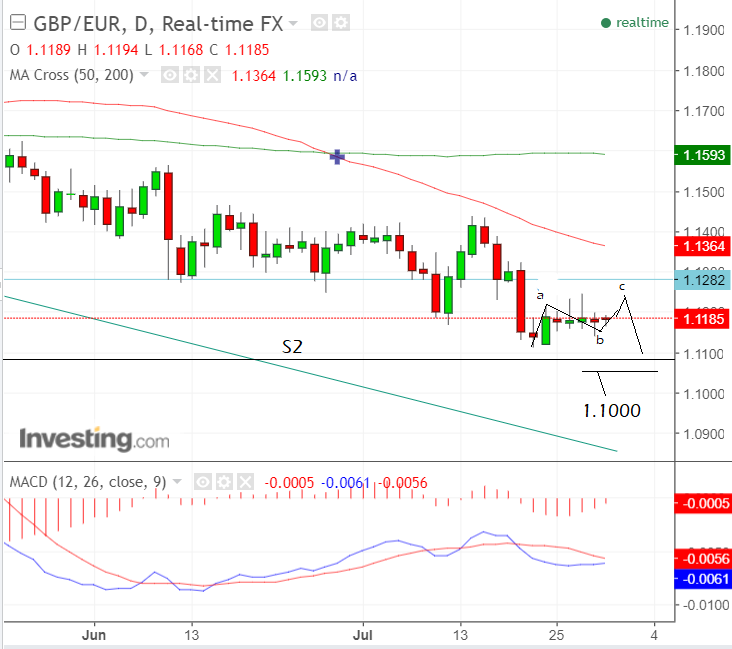GBP/EUR Exchange Rate: Technical Forecast at Start of the New Month

The Pound to Euro exchange rate is correcting here within a dominant short-term downtrend.
The pull-back will probably not last long and eventually the downtrend is expected to resume taking the pair lower.
The correction is probably a three-wave abc corrective pattern (see chart below) with wave-c as yet still to unfold.

Once it has unfolded (higher) roughly up to 1.1250 it will probably rotate and move lower again, moving back down in line with the dominant trend.
The exchange rate will probably encounter a substantial amount of support at the S2 monthly pivot situated at 1.1094 which is likely to prove an obstacle to further downside.
Monthly pivots are calculated from the previous month’s open high low and close and gives traders an idea of whether the market is over-extended or not.
Often prices turn at pivots so we would ideally wish to see S2 broken before expecting more downside.
Such a break would be confirmed by a break below the 1.1060 level, with a target then at the psychologically significant round number of 1.1000.
“Attempts to reverse ongoing Sterling weakness here have not proven conspicuously successful in recent weeks and while the angle of descent is still relatively shallow prices nonetheless look to be “stair-casing” their way back towards 1.1000 again," says analyst Lucy Lillicrap at Associated Foreign Exchange.
Get up to 5% more foreign exchange by using a specialist provider. Get closer to the real market rate and avoid the gaping spreads charged by your bank for international payments. Learn more here.
This Week's Data and Events for the Pound
The Bank of England (BOE) rate meeting is the main release for the Pound in the week ahead.
The meeting, scheduled at 12.00 BST on Thursday, August 3, is not expected to result in a change of policy, despite the relatively close vote of 5-3 not to raise interest rates at the previous meeting.
“There has been a lot of speculation that the BoE is about to change tack. But, for now, policy still seems set to remain on hold,” said Lloyds Commercial Banking’s, chief economist, Rhys Herbert, who forecasts a 6-2 split in favour of keeping interest rates unchanged.
TD Securities agree with the view that the BOE will vote 6-2 to stay on hold:
“While the BoE took a more hawkish stance in June with a 3 MPC members voting for a hike, we look for a 6-2 vote this time as the uber-hawk Forbes departs and most top-tier data has surprised to the downside since Haldane’s hawkish speech in June.”
Recent strong GDP data is probably not going to be enough to encourage a rate rise, despite coming out up by 0.3% on the previous month – against 0.2% forecast – and 1.7% higher on an annualized basis as this is still well below the rate of inflation which is circa 2.7%.
RBS’s chief economist notes how the dominant Services sector is holding overall growth up.
He adds that there are two schools of thought about this, with the first composed of optimists, for whom, “the strength of the service sector, representing 80% of the economy, shows the underlying resilience of growth with services now 2.3% bigger than a year ago,” whilst pessimists argue that the, “falls in production output are being masked by a short-lived expansion of services that’s doomed to fall victim to the real income squeeze.”
The BOE’s quarterly inflation report will also be released on Thursday, however, the consensus estimate is for little change to forecasts.
The other major releases for the Pound in the week ahead are manufacturing, construction and services PMI’s released.
The data should give a snapshot as to whether the uptick in economic activity seen in the second-quarter of 2017 is extending into the third-quarter.
Tuesday's manufacturing PMI is forecast to read at 54.4, up from the previous month's 54.3.
Wednesday's manufacturing PMI is forecast to read at 54.5, down from a previous 54.8.
The most important of this data series comes on Thursday with the release of service sector PMI which is forecast to read at 53.6, up from a previous 54.3.
This Week's Data for the Euro
Eurozone inflation and unemployment data for July has already just been released on Monday morning and has beaten analyst’s expectations after core rose to 1.2% and unemployment fell to 9.1%.
Overall data is expected to continue supporting the Euro as it will probably continue to show slow but steady growth but we do note that the positive reaction has been somewhat muted. Is the Euro's strong rally showing signs of fatigue? This could indeed be the case.
Purchasing Manager Indices for manufacturing and services are out on Tuesday, August 1 and Thursday, August 3 respectively, at 9.00 BST, and are expected to show no change from 55.8 and 55.5 in June, which was, nevertheless, an 8-month low.
Eurozone GDP data for the second quarter is out at 10.00 on Tuesday and forecast to show a 2.4% rise year-on-year – from 1.9% previously - and 0.4% in Q2 compared to Q1.
The European Central Bank’s Economic Bulletin is scheduled for release at 9.00 on Thursday.




